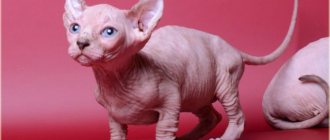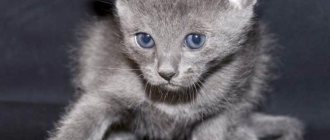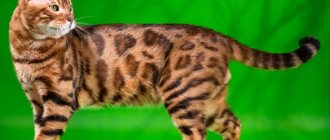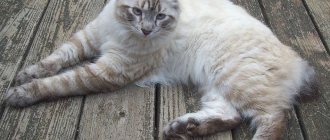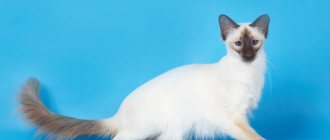Advantages and disadvantages
- Pros:
- sociability, contact and almost dog-like devotion;
- love for other animals and children;
- Easy to care for – many Bengals love to swim, unlike other breeds.
- Minuses:
- high cost - even the cheapest pet-class kitten costs a decent amount;
- Bengal cats are also not the cheapest breed to keep - they need premium food and a lot of toys;
- Hyperactivity in Bengal cats can be a problem if there is no activity appropriate for it in the home.
Key facts
The Bengal cat is a popular and expensive breed. These are beautiful, graceful animals, outwardly standing out among other cats with their rare color.
The description of the Bengal cat breed says that these animals love games, walks, and move a lot. They have a sharp mind and can even be trained, so representatives of this breed can be seen among participants in cat agility. Bengal cats are suitable for equally active and experienced cat owners.
The Bengal distinguishes its owner from other people and quickly and easily gets used to the family. He is not aggressive, unpretentious and loves children.
A pleasant characteristic of the Bengal cat: representatives of this breed are clean and, unlike other cats, love to splash in the water.
Bengals are regular participants and stars of exhibitions, favorites of experts and breeders. They are regularly included in the top of various ratings of the best and most beautiful cats.
The owner of a Bengal cat becomes the owner of a pet leopard, which has the grace and beauty of large feline predators, but at the same time is completely safe for living together.
The final advantage is the high life expectancy of the Bengal cat: this large pet can live in good health for 15 years.
What to do if your Bengal begins to gain weight poorly
Having noticed deviations in weight gain, you should determine the reasons for this.
Bengals are one of the cat breeds that lead an active lifestyle.
A few common reasons:
- Poor nutrition. Underweight occurs if the kitten is malnourished or does not receive enough nutritional components. Make sure that the kitten eats 6 times a day and has constant access to clean drinking water.
- Refusal to eat. This problem especially often occurs among owners who purchased a kitten from a breeder. The pet may already be accustomed to a certain food and refuse to eat a new one. In this case, you should transfer the kitten to a new food gradually.
- Stress. Sudden changes in environment and other factors can provoke stress. When stressed, kittens may refuse to eat. As a rule, adaptation takes from a couple of days to a week, after which the pet begins to eat normally and gain weight again.
- Diseases. If a Bengal eats properly, but still does not gain weight well, this may indicate diseases of the digestive system. In this case, you should definitely show your pet to a veterinarian.
- Parasites. Weight loss may indicate the presence of worms. Prevention against parasites should be carried out every six months starting from three weeks of age. For kittens, a suspension is used: it is easier to administer into the body.
History of the origin of the Bengal cat
The breed owes its existence in its current form to the American felinologist Jean Mill. Almost single-handedly, for many years she was engaged in the selection and improvement of Bengal cats.
It all started in 1961, when Jean, while in Bangkok, saw wild Bengal cat kittens for sale. Wild Bengals themselves were hunted and destroyed for the sake of a beautiful skin. Jean bought one kitten, named him Malaysia and brought him to the USA. Although the wild cat grew up at home, it was distrustful, non-communicative, preferred solitude, but did not show any aggression towards people.
At the call of nature, the grown-up cat accepted the courtship of the black domestic cat Jean. As a result of this union, a female kitten with the color of a wild Bengal cat was born, who received the nickname Kin-Kin. Kin-Kin had two kittens from inbreeding with her father, one of which died tragically, and the second did not inherit the color. Experiments to breed a hybrid were interrupted by Kin-Kin's death from pneumonia. Malaysia was sent to the zoo.
Breeding of the new breed resumed only 15 years later. Jean learned about scientific experiments in the laboratory of the University of California, as a result of which offspring were obtained from domestic and wild leopard cats. The leader of the experiment, Willard Centerwall, gave Jean Mill 9 females of the first hybrid generation. These cats became the founders of a new breed of domestic Bengal cats.
Until 1982, Jean bred cats with Burmese and Mau cats. In 1982, Jean acquired a wild golden kitten from a zoo in India and brought him to the United States. The kitten, named Delhi, was registered with the Cat Fanciers Association as an experimental Mau. In matings, Deli consistently passed on the shine of the coat to the offspring, which was established in a breed called glitter, and in 1983 Jean registered the first kitten of the new breed with TICA. But most of the cats of the first generations suffered from infertility, so Jean used wild Bengals for breeding.
A large number of Mau and Ocicat breeders reacted negatively to Mill's breeding activities due to reluctance to compete and inbreed with wild cats. As a result of such opposition, Bengals were not recognized for a long time by the association of cat lovers in the United States, although since 1985 they have been triumphantly presented at exhibitions, winning the hearts of visitors and experts.
Over the next 20 years, Jean Mill continued her breeding activities, introducing the blood of several more wild Bengals and creating several working lines of the breed.
What could go wrong
Hypoglycemia, hypothermia, and dehydration are common causes of early death in newborn kittens. This syndrome develops in the first three weeks, when the ability to regulate temperature is still weak and the body's carbohydrate reserves are meager. Lethargy, apathy, sometimes against the background of convulsions, may indicate incipient hypoglycemia. The problem occurs as a result of insufficient feeding. There is not enough breast milk if:
- a nursing mother produces little milk;
- there is a delay in lactation;
- the number of offspring exceeds normal.
The condition is diagnosed by a doctor who injects the kitten with a glucose solution. It is important to pay attention to the symptoms in order to immediately provide assistance to the newborn. Bottle feeding with a milk replacer will help compensate for the lack of nutrients.
Before feeding, the kitten must take its temperature. If it is below 34 degrees, you cannot feed. Hypoglycemia is often accompanied by hypothermia. The newborn is not yet capable of thermoregulation. If the cat for some reason stops keeping him warm, hypothermia will occur.
At temperatures below 34 degrees, the digestion process is disrupted, the sucking reflex is reduced, and the kitten may simply choke on milk and die. You first need to gradually warm the kitten up, and then start feeding it. Several factors can help prevent hypothermia:
- regular temperature measurements in the nest;
- observing the behavior of a cat that should be with its offspring;
- control the humidity level in the nest.
Infrared lamps are used to warm kittens. They should not hang too low to avoid another problem - overheating. The normal humidity level is considered to be 60%. If the surrounding air is too dry and the newborn does not receive enough water (about 15 ml per 100 g of weight), dehydration will occur. Loose stools can provoke this situation.
A blind kitten's skin surface area is very large compared to its mass. In a warm, dry place, moisture evaporates quickly and dehydration occurs. It is necessary to regularly check whether the kittens are sucking milk and whether access to the nipples is restricted. Severe dehydration is treated with perfusion, intravenous or intraosseous, performed by a veterinarian. Subcutaneous injections at such an early age are ineffective and sometimes cause new diseases: abscesses, osmotic dehydration, etc.
These three conditions: underfeeding, hypothermia and dehydration are interconnected, since one of them can provoke the development of other dangerous processes. The kitten should be in a warm nest with relatives and have access to mother's milk. If your pet appears weak, you should:
- measure rectal temperature;
- warm him up if it is too low;
- give the warmed kitten a drink of sweetened water;
- feed him artificial milk;
- invite a veterinarian for an examination.
These simple measures and careful attention will help save the newborn’s life and get him out. The next problem that little Bengals face is bacteriological infections. They can affect the navel (omphalitis), eyes (ophthalmia), skin (septicemia). Preventing diseases is both simple and difficult. It is necessary to ensure hygiene procedures without disturbing newborns too much.
Umbilical infections can cause peritonitis. It is necessary to regularly monitor the condition of the navel. Diagnosis and antibacterial treatment are prescribed by a veterinarian. Eye infections are hidden and begin even before the eyes open. If, when you press on the eyelid, a drop of pus flows out from under it, you should immediately show your pet to a doctor.
To remove purulent deposits, it may be necessary to artificially open the eyelids. Next, the pet is treated with eye drops. If the condition is not detected early, the kitten will suffer from eye problems for the rest of its life or will lose its vision completely.
Skin infections thrive especially in damp environments. Therefore, the bathroom is not the best place for a cat's nest. Other causes of skin lesions in newborns may include:
- infection in the mother (infection occurs during childbirth);
- unsatisfactory hygienic condition of the nest;
- little or no colostrum.
If there is no hygiene, the nest stinks, this is unacceptable. Skin infections must be treated by a veterinarian, who will determine the type of bacteria and prescribe appropriate medications. In the absence of timely assistance, microbes or their products - toxins - enter the bloodstream, which leads to serious illness and death. Signs of neonatal infection may include:
- lethargy and apathy;
- eyes water;
- pinpoint hemorrhages on the skin;
- diarrhea;
- rectal prolapse;
- purulent discharge in the corners of the eyes;
- abscesses on the skin.
Any of these signs are reason to consult your veterinarian immediately. Some breeders give pregnant cats antibiotics as a preventive measure. This is a very bad practice because kittens develop disturbances in their intestinal bacterial flora and develop strains that are resistant to antibiotic treatment. Such drugs should be prescribed to a pregnant cat by a doctor if there are appropriate indications.
If your Bengal kitten is sneezing, he probably has a cold. But respiratory tract irritation may have other causes. Their presence or absence must be confirmed by a veterinarian. In parallel with antibacterial therapy, vitamins are prescribed.
It is worth noting that Bengals inherited excellent health from their wild ancestors. If kittens are provided with proper care, they grow healthy and strong.
Similar cat breeds
Abyssinian cat
Egyptian Mau
Oriental cat
What does a Bengal cat look like?
Despite their large size, cats and cats look very elegant. They are characterized by true feline grace, and the skin stands out due to its special shine and color character. In the photo, the Bengal cat is not as beautiful as in life, because the photo cannot convey its luxury.
Muzzle
The head of a Bengal cat is wedge-shaped with smoothed corners. The back of the head is smoothly continued by the neck, and the size of the skull is medium-sized, in good harmony with the general appearance of the animal. The profile according to the American standard should be straight from the brow ridges, and according to the European standard the transition from the forehead to the nose may stand out a little.
The nose itself is quite large and is in line with the chin. The jaws are well developed; in adult cats, the cheeks stand out. The ears are relatively small, fit harmoniously into the lines of the skull and, unlike most other breeds, have rounded rather than sharp tips.
Bengals' eyes are almost round and very expressive. Their color depends on the color of the animal and can range from light green to golden and from pale blue to aquamarine.
Body type
What does a Bengal cat look like? The body is muscular, with strong bones and a well-developed chest. The Bengal cat is graceful, rectangular in size, but not of the oriental type. It is not as large as the Maine Coon, but is larger than most modern breeds. Weight reaches 9 kg, height - up to 32 cm at the withers, and length with tail can reach a meter.
The photo clearly shows that males are much larger. Despite the fact that Bengals grow up to 24 months, the main growth ends at 9 months. The limbs are muscular and go well with the overall appearance of the Bengal, and the tail is thick, of medium length with a rounded tip.
Coat and color
The color of the Bengal cat makes it stand out from others; the main breeding was carried out on it. It should be contrasting, although kittens have such a wild heritage as phasing - at 3-4 weeks the skin of a purebred kitten turns pale, and again becomes contrasting after a couple of months. The pattern itself can be marbled or spotted, but, in any case, the spots should be clearly defined.
There should be no white spots. The Bengal's coat should be short and close to the body. Wool of medium or longer length is considered a significant fault. Now there are 6 varieties of Bengal cats by color:
- brown tabby;
- silver tabby;
- seal sepia tabby;
- seal mink tabby;
- blue tabby;
- seal links point.
All cats of the breed must have the effect of shining fur - that same glitter.
Coat color
Thanks to its wild color, the Bengal cat has gained worldwide fame. A large list of colors is officially recognized, which is presented in the photo. The main requirement for fur is maximum contrast between the background and the pattern. The paws and tail are always distinguished by a pattern in the form of stripes rather than spots.
Interesting!
Kittens may be born light colored. As you get older, a pattern will emerge. The kitten's final Bengal color appears at 8 months.
By pattern type
The color of Bengal cats is not only multi-colored, but also has different patterns. There are several dominant colors: leopard, spotted and marbled.
Leopard (Rose)
These are the most common colors. Already from the name it is clear that this is a pattern consisting of beautiful spots of “rosettes”. The outline of the rosette is highlighted in black or dark brown. The core is darker than the main fur, but lighter than the outline. The socket can have a closed or open circuit.
Spotted (Spot)
The description of the spotted pattern is quite simple - these are monochromatic spots of dark color located throughout the fur. They should be very bright and contrasting. Usually their size is slightly smaller than that of a socket. There are different types of stains. Most likely they will be round, but there are also oval, elongated spots.
Marble (Marble)
The marble color is much less common than leopard and spotted patterns. The stripes are located along the fur coat, and not across, like the usual stripes of the British. The Bengal marbled cat has spots of various shapes. The main condition is their clear outline. The marbled cat looks more like a tiger cub than a leopard.
By coat shade
The color of Bengal cats is divided into 5 main shades of fur. The golden shade is considered classic. In addition to it, there are silver, snow, blue and charcoal colors.
Golden (Brown)
The main color of the coat varies from golden yellow to light brown. The spots are highlighted in dark brown or black. The eye color is green or golden. The tip of the tail is always marked black.
Silver
The background fur is white, gray or silver, steel. The tip of the tail is also marked with a black spot. The markings on the fur are gray with a black outline. The eye color is green or golden.
Snow
Snow color is further divided into snow lynx, mink, sepia - from lightest to darker. In general, the snow cat has a light fur color - cream or ivory. Sometimes the fur is almost white. The marks can be light, as if faded, or more pronounced - beige, dark brown. Eyes can be blue, green, green-blue, golden.
Snowy colors are valued by breeders. Less often it can be found in combination with a marble pattern.
Blue
The fur is gray with a blue tint. These types of colors are not found very often. The main thing in describing this color is the cold undertone of the coat. The spots are gray-blue or dark gray. The iris color is green, brown or golden. The end of the tail is highlighted in dark grey.
Coal
The main color of the fur is charcoal, dark gray or brown. The Bengal cat in the photo is a perfect example. This photo shows fur with a cool undertone. The spots are highlighted in an even darker shade. Outwardly, it looks like the cat really got dirty in something charcoal-dark. The muzzle has a patterned mask with white circles around the eyes. Eye color is green, golden or brown.
Bengal cat personality
Despite their close wild roots, Bengals are devoid of aggressiveness, very sociable and friendly with proper socialization. The character of the Bengal cat is partly “canine”; it needs people and communication much more strongly than most representatives of the cat family.
This breed loves children and all family members. They get along well with other animals, including dogs. But due to their highly developed hunting instinct, it is not recommended to keep them together with birds, rodents and even fish, since Bengals love to swim. You shouldn't be surprised if you find your pet in the bath you've drawn for yourself.
The Bengal cat, despite all its sociality, does not like to be cuddled when it is not in the mood. But if the Bengal is tuned to tactile contact, you won’t get rid of it so easily! They also love to talk. Their meow is rich in nuances, and an attentive Bengal owner can understand it quite well.
The Bengal cat's main personality trait (and flaw for some) is hyperactivity. Both the kitten and the adult cat are ready to run around day and night. A bored and unoccupied Bengal can cause a lot of trouble at home, so this breed should have a lot of toys that keep them well entertained, and tall, branched cat “towns.”
Who is the Bengal cat suitable for? Families with children, dogs, other cats, active young families without children, breed lovers who are ready to work with animals.
Raising a Bengal cat
Bengal cats have a sharp mind and cunning. They easily adapt to any conditions. Their intelligence combined with high activity makes them suitable candidates for learning tricks and certain commands. Many cats of this breed participate in cat agility competitions. Physical methods of punishment are unacceptable, and they are not necessary - Bengals are sensitive to the intonation of the owner’s voice.
The Bengal's intelligence and ability to analyze allow him to learn how to open cabinets, doors to rooms, turn on faucets and do other repetitive tasks at home.
Many potential owners, due to the presence of wild cat genes, are wondering how to toilet train a Bengal and how easy it is. Don't worry: Bengals quickly understand where to relieve themselves. Sometimes, if the kitten has chosen a place for himself, it is enough to put a tray there.
There should be a lot of filler in the tray, as representatives of this breed dig deep holes. Clean Bengals' toilets need to be cleaned on time. If you follow these simple rules, there will be no problems with training.
Looking for a Bengal cat? Find your pet from 3 offers Buy as a gift
Bengal cat health
Possible diseases
The health of the Bengal cat is good, in addition, they are long-lived. Until recently, their only problem was a tendency to problems with the gastrointestinal tract, which were solved by choosing the right food and a selected diet and diet. However, Bengals are not prone to allergies. But now breeders identify several quite serious congenital and hereditary diseases in the breed:
- flat chest syndrome;
- hypertrophic cardiomyopathy;
- polycystic kidney disease;
- leukemia and leukemia;
- thickening of the heart muscle.
All these diseases require careful monitoring by a veterinarian and timely adequate treatment.
Reproductive health
Female Bengal cats mature at about one year of age. Although heat may occur earlier, it is not recommended to breed a cat before one year of age. Males are usually ready to mate by 9 months.
Bengal cats have a regular cycle: most females go into heat four, and in rare cases, five times a year. The estrus itself lasts 8-11 days: in the first period (proestrus, about three days), the cat becomes very affectionate and behaves characteristically, but will not let the cat near. The second period (estrus) lasts about 8 days, during which time the female actively purrs, withdraws her tail, and tramples. Now she is ready to accept a cat, these 8 days are a suitable period for mating. Cats do not have bloody discharge during estrus, so if you notice it, then this is a reason to contact your veterinarian.
Mating takes place on the territory of the male, the female is brought to him for several days. Some animals get to know each other and take a closer look at each other, and some immediately mate. After successful mating, the cat becomes calm.
Pregnancy occurs easily in a cat, 90% of animals become pregnant on the first try, but this can only be confirmed by ultrasound after a couple of weeks. The pregnancy of a Bengal cat lasts 64 days, slight deviations, plus or minus, are possible.
Starting from the third week, the cat’s food is increased by 10%, and towards the end the cat eats less. If she refuses to feed, childbirth is close, and it’s time to think about organizing the birth and postpartum space. The Bengal needs a place that is closed on all sides with soft bedding. A house or just a box with a cut-out entrance would work well. It is better to put a disposable diaper inside.
Childbirth usually goes well; some problems are possible in primiparous cats. There are usually 2-4 babies in a litter; more numerous offspring are rare. Bengal cats are excellent, caring mothers. After giving birth, you should not disturb the mother and babies for several days.
Nevertheless, Bengals are quite difficult to breed by selecting a pair. This is a complex analysis and comparison of genes, advantages and disadvantages of ancestors and lines. Deficiencies must not be allowed to become established in the breed. Therefore, it is advisable that an experienced breeder be involved in the selection of a partner.
Individuals with serious breed defects should not be bred. Breeding with other breeds other than wild Asian cats is not allowed. Therefore, in order to avoid uncontrolled matings, many kittens are sold with the condition of sterilization or castration. These simple operations will relieve your cat of unsatisfied desire and the resulting behavioral problems. In addition, sterilization and castration eliminate the occurrence of cancer of the reproductive organs.
How do Bengals develop?
| Days, months | Events, activities |
| 5-8 days | The ear canal opens |
| 7-12 days | Eyes open |
| 12-21 days | The first teeth appear |
| 13-16 days | Ability to navigate by sound |
| from 14 days | Vision becomes clearer |
| from 18 days | First claw trimming Ability to stand on paws |
| 21-30 days | Learn to walk ; Fang trimming and deworming if necessary |
| from 30 days | Start of complementary feeding, toilet training |
| 5-10 weeks | Routine prevention of helminths Immunity borrowed from the mother weakens |
| 6-16 week | Vaccination |
| 8-12 week | Revaccination |
| 3 months | Moving to a new home |
| 12-14 week | Permanent teeth appear, immunity decreases |
| 3.5-7 months. | Routine vaccination |
| 6 months | Puberty |
| 4-20 months | Sterilization, castration |
“Gaining excess weight is not common in Bengal kittens, but if it happens, you should contact your veterinarian.”
Features of feeding and diet
Bengal cats have delicate stomachs, so it is best to feed them a premium, balanced dry food. The change of food should be gradual, and dry food should not be mixed with natural food.
If the owner still wants to feed the cat natural food, then the bulk of the diet should be lean meat and offal. It is better to give sea fish and not very often - 1-2 times a week. In addition, the diet should include fermented milk products and some vegetables. Cats should not be given whole milk. It is better to cook for Bengals separately - you should not feed them from the common table. For natural breeding cats, vitamin complexes should be added to their food.
Bengal cats are fed 3-4 times a day, and water should be freely available. Bengals love to drink from special drinking fountains.
Care and maintenance
Caring for and maintaining a Bengal cat does not cause any trouble, as these animals are unpretentious. They do not require haircuts or frequent combing. Their fur does not tangle. There are usually no problems with washing cats; on the contrary, you will have to make sure that the Bengal does not bathe too often.
Nails are trimmed a couple of times a month. Ears and eyes are cleaned as they become dirty. Sometimes you can brush your teeth with a special toothpaste or buy your cat special chewing treats.
A Bengal cat should have its own place where it can retire. Often cats ignore specially purchased houses and choose the most incredible places.
The cat's home must be safe. Pay special attention to house plants - some familiar and ordinary flowers can become real poison for an animal. Many cats love to chew greens, so to satisfy this desire, you can buy her special grass in the store, which will also be an additional source of vitamins.
It is necessary to take into account the active nature of the breed and provide it with a place where the cat can splash out its energy - a cat town, a playroom, etc.
If you live in an apartment, you should not keep windows and loggias open. Bengals are not at all afraid of the street, and a walk along the ledge can lead to tragedy. It is better to attach mesh to the windows. But the breed is suitable for walking on the street, although it is better to walk in the city on a leash and at the same time make sure that there are no aggressive dogs on the horizon.
Tips for choosing a kitten
The Bengal cat is a fairly expensive breed, so you shouldn’t chase a low price and buy a kitten secondhand, without documents, on dubious online bulletin boards or a bird market. It is best to contact a nursery or breeder with a good reputation. Only there you can find Bengal kittens that fully meet the standards.
What is important:
- a Bengal kitten must have documents: a pedigree indicating the generation, and a veterinary passport with the first vaccinations;
- a good breeder will not sell a kitten under two months old;
- a Bengal kitten at the age of sale weighs about a kilogram;
- the kitten should be active, playful, with clean eyes and ears, shiny shiny fur;
- he should not hiss and break out of his hands - a poorly socialized kitten will be wild and isolated;
If you are purchasing a kitten for exhibitions or, especially, breeding, pay attention to the absence of defects and defects.
Castration and sterilization
This procedure is necessary for Bengal cats whose breeding is not intended. Otherwise, semi-feral cats will begin to mark their territory, tear apart furniture and even become aggressive.
Early castration of males is carried out at the age of 3-3.5 months. Cats are sterilized at 5-6 months. In general, adult animals tolerate surgery well before the age of 2 years.
Important!
Spaying and neutering relieves the cat of the extreme stress that she experiences during the period of estrus, not being able to complete the reproductive cycle.
How much does a Bengal cat cost?
Purebred kittens with documents cost from 15,000, and the final cost can reach 150 thousand or more. The rarest and most expensive color is blue tabby; the price of a Bengal cat with this shade ranges around one hundred thousand.
The lowest price is for pet class pets. These are cats with defects in color and appearance; they are not allowed for exhibitions and breeding, and are usually sold for sterilization. The cost of such kittens varies from 15 to 30 thousand rubles.
Breed-class cats are already more expensive. They will not be show stars, but do not deviate from the standard and can be accepted for breeding. If the animal is sold with the condition of sterilization, then the price will be lower - 30-50 thousand rubles, and if with the possibility of breeding, then higher - 50-70 thousand.
The most expensive cats are show class. These representatives of the breed are purchased for exhibition career and breeding. Their cost starts from 60 thousand rubles for sterilization, and how much an animal with permission for breeding will cost depends only on the cat itself and the seller. Typically the starting price is 80 thousand.
Do you like the article? 0
How to choose a kitten, its cost
There are kittens of the early generation (basic Bengals F1). One of their parents is a wild leopard cat. The kittens retain the wild habits and distinct external characteristics of a wild leopard cat. In terms of size, they can be larger than ordinary cats. They are not suitable for exhibitions. Usually they like to buy them for breeding in order to improve the overall gene pool.
A more budget option is SBT-Bengalis. Their wild ancestor was in the fifth or more distant generation. The four previous generations of Bengal cats and cats consisted of purebred pedigree Bengals. Such kittens are more flexible, affectionate, and get used to being handled more easily. Outwardly, they are more reminiscent of domestic cats, but even here you should be prepared to show character.
Important!
The optimal generation characterizing a purebred Bengal is F4-F7. Sometimes kittens are reserved immediately after birth, because... This species bears 1-3 kittens.
The breeder must provide a pedigree, a vaccination passport, and may need the results of tests and studies confirming the health of the pet.
To choose a healthy kitten, you need to know the signs of a healthy animal:
- clear, open and interested look;
- lack of mucus in the corners of the eyes;
- smooth and beautiful fur, without bald spots or tangles;
- confident gait (if the baby is less than 3 months old, hesitant behavior is allowed);
- interest in guests, lack of aggression in the kitten and mother;
- the breeder must show the kitten’s mom and dad so that there is no doubt about the purebred of the breed;
- You should definitely meet the breeders and animals face to face.
Many people are interested in exactly how much a kitten costs. However, it is impossible to give a fixed price. The minimum cost of a kitten is 20-25 thousand rubles. The price can rise to 60-100 thousand rubles. If the animal has minor defects, it will cost less. If the pet is planned to be used for breeding, the price will be higher. The cost depends on the rarity of the color.
It is better to purchase females for breeding, and males for exhibition careers. Kittens are adopted no earlier than three months of age. At this point, they easily switch to solid food, are trained to the tray, and have the necessary vaccinations.
Important!
To buy a Bengal, it is better to find an official nursery where kittens are taught to be handled from birth. Cats cannot be kept in enclosures.



